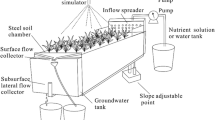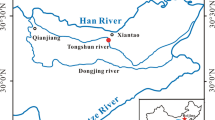Abstract
Metolachlor and atrazine are herbicides used in corn agriculture and detected in surface- and groundwater. Vegetated filters reduce masses of herbicides in runoff, but less attention has been given to their impact on degradation products and subsurface infiltrated water. The objective was to study the temporal evolution of dissolved metolachlor, atrazine and deethylatrazine concentrations in runoff and subsurface infiltrated water with two types of vegetated filters over 2 years for the first three rains following herbicide application. Runoff and subsurface infiltrated at 90-cm water samples from 12 plots of 30 × 5 m in a completely randomized block design of four replicates of three treatments-control without filter, 5-m-long grass filter, 5-m-long grass and tree filter were analysed using gas chromatography/mass spectrometry. Controls in runoff generally had the highest average atrazine, as high as 739 μg L−1, and metolachlor average concentrations, as high as 1,725 μg L−1. The first rain after application was mainly responsible for atrazine and metolachlor exports. Vegetated filters reduced concentrations of atrazine and metolachlor in runoff below their respective Canadian criterion of 1.8 μg L−1 for atrazine and 7.8 μg L−1 for metolachlor (provisory) (CCME 2002) for the protection of aquatic life when rain did not occur shortly after application. With the need to increase food production and agricultural yields to sustain the increasing world population came the need to develop efficient mitigation tools such as vegetated filter strips to reduce the ecotoxicologial impacts of pesticides. The present study is among the few that examined herbicide degradation products and subsurface infiltrated water under filter strips in order to provide new knowledge on the relationship between herbicide loss pathways and the environmental benefits of these strips. Such knowledge will provide much needed information to modellers, decision makers, ecotoxicologists and agronomists involved in the regulation, design and implementation of vegetated filter strips for the protection of water quality.




Similar content being viewed by others
Abbreviations
- CCME:
-
Conseil Canadien des Ministres de l’Environnement
- K oc :
-
Soil organic carbon distribution coefficient
- LC50 :
-
Median lethal concentration
- a.i.:
-
Active ingredient
- ANOVA:
-
Analysis of variance
References
Arora K, Mickelson SK, Helmers MJ, Baker JL (2010) Review of pesticide retention processes occurring in buffer strips receiving agricultural runoff. J Am Water Resour Assoc 46(3):618–647. doi:10.1111⁄j.1752-1688.2010.00438.x
Barth JAC, Steidle D, Kuntz D, Gocht T, Mouvet C, von Tümpling W, Lobe I, Langenhoff A, Albrechtsen H-J, Janniche GS, Morasch B, Hunkeler D, Grathwohl P (2007) Deposition, persistence and turnover of pollutants: first results from the EU project AquaTerra for selected river basins and aquifers. Sci Total Environ 376:40–50. doi:10.1016/j.scitotenv.2007.01.065
Bayless ER (2001) Atrazine retention and degradation in the vadose zone at a till plain site in Indiana. Ground Water 39(2):169–180. doi:10.1111/j.1745-6584.2001.tb02298.x
Caron E, Lafrance P, Auclair JC, Duchemin M (2010) Impact of grass and grass with poplar buffer strips on atrazine and metolachlor losses in surface runoff and subsurface infiltration from agricultural plots. J Environ Qual 39:617–629. doi:10.2134/jeq2009.0041
Conseil Canadien des Ministres de l’Environnement (CCME) (2002) Recommandations Canadiennes pour la qualité de l’environnement, updated 2002. le Conseil, Winnipeg
Duchemin M, Hogue R (2009) Reduction in agricultural non-point source pollution in the first year following establishment of an integrated grass/tree filter strip system in southern Quebec (Canada). Agric Ecosyst Environ 131:85–97. doi:10.1016/j.agee.2008.10.005
Enoch RR, Stanko JP, Greiner SN, Youngblood GL, Rayner JL, Fenton SE (2007) Mammary gland development as a sensitive end point after acute prenatal exposure to an atrazine metabolite mixture in female Long-Evans rats. Environ Health Perspect 115(4):541–547. doi:10.1289/ehp. 9612
Faust M, Altenburger R, Backhaus T, Blanck H, Boedeker W, Gramatica P, Hamer V, Scholze M, Vighi M, Grimme L (2001) Predicting the joint algal toxicity of multi-component s-triazine mixtures at low-effect concentrations of individual toxicants. Aquat Toxicol 56:13–32. doi:10.1016/S0166-445X(01)00187-4
Finizio A, Diguardo A, Arnoldi A, Vighi M, Fanelli R (1991) Different approaches for the evaluation of Kow for s-triazine herbicides. Chemosphere 23:801–812. doi:10.1016/0045-6535(91)90084-Q
FOOTPRINT (2006) The FOOTPRINT Pesticide Properties DataBase. Database collated by the University of Hertfordshire as part of the EU-funded FOOTPRINT project (FP6-SSP-022704). http://www.eu-footprint.org/ppdb.html. Accessed February 2012
Howard PH, Meylan WM (1997) Handbook of physical properties of organic chemicals. CRC Press Inc, Lewis Publishers, Boca Raton
Hua WY, Bennett ER, Maio XS, Metcalfe CD, Letcher RJ (2006) Seasonality effects on pharmaceuticals and s-triazine herbicides in wastewater effluent and subsurface water from the Canadian side of the upper Detroit River. Environ Toxicol Chem 25(9):2356–2365. doi:10.1897/05-571R.1
Huber W (1993) Ecotoxicological relevance of atrazine in aquatic systems. Environ Toxicol Chem 12:1865–1881
Kegley SE, Hill BR, Orme S, Choi AH (2010) PAN Pesticide Database, Pesticide Action Network, North America, San Francisco, CA, http:www.pesticideinfo.org. Accessed February 2012
Krutz LJ, Senseman SA, Dozier MC, Hoffman DW, Tierney DP (2003a) Infiltration and adsorption of dissolved atrazine and atrazine metabolites in Buffalograss filter strips. J Environ Qual 32:2319–2324
Krutz LJ, Senseman SA, McInnes KJ, Zuberer DA, Tierney DP (2003b) Adsorption and desorption of atrazine, desethylatrazine, deisopropylatrazine, and hydroxyatrazine in vegetated filter strip and cultivated soil. J Agric Food Chem 51(25):7379–7384. doi:10.1021/jf0348572
Lacas JG, Voltz M, Gouy V, Carluer N, Gril JJ (2005) Using grassed strips to limit pesticide transfer to surface water: a review. Agron Sustain Dev 25:253–266. doi:10.1051/agro:2005001
Lafrance P, Guibaud G, Bernard C (2001) Rendement de zones tampon herbacées pour limiter les pertes d’herbicides en phase dissoute par ruissellement de surface. In Actes du 30ième Congrès du Groupe Français des Pesticides, Reims, May 29th–31st 2000
Ogram AV, Jessup RE, Ou LT, Rao PSC (1985) Effects of sorption on biological degradation rates of (2,4-dichlorophenoxy) acetic acid in soils. Appl Environ Microbiol 49:582–587
Patty L, Réal B, Gril JJ (1997) The use of grassed buffer strips to remove pesticides, nitrate and soluble phosphorus compounds from runoff water. Pestic Sci 49:243–251
Ralston-Hooper K, Hardy J, Hahn L, Ochoa-Acuña H, Lee LS, Mollenhauer R, Sepúlveda MS (2009) Acute and chronic toxicity of atrazine and its metabolites deethylatrazine and deisopropylatrazine on aquatic organisms. Ecotoxicology 18:899–905. doi:10.1007/s10646-009-0351-0
Rice PJ, Anderson TA, Coats JR (2004) Effect of sediment on the fate of metolachlor and atrazine in surface water. Environ Toxicol Chem 23:1145–1155. doi:10.1897/03-110
Solomon KR, Baker DB, Richards RP, Dixon KR, Klaine SJ, La Point TW, Kendall RJ, Weisskoff CP, Giddings JM, Giesy JP, Hall LW Jr, Williams WM (1996) Ecological risk assessment of atrazine in North American surface waters. Environ Toxicol Chem 15(1):31–76.
Spencer WF, Cliath MM (1991) Pesticide losses in surface runoff from irrigated fields. In: Pawlowsi L et al (eds) Chemistry for the protection of the environment. Plenum Press, New York, pp 277–289
Syversen N, Bechmann M (2004) Vegetative buffer zones as pesticide filters for simulated surface runoff. Ecol Eng 22:175–184. doi:10.1016/j.ecoleng.2004.05.002
Thurman EM, Meyer MT, Mills MS, Zimmerman LR, Perry CA (1994) Formation and transport of deethylatrazine and deisopropylatrazine in surface water. Environ Sci Technol 28:2207–2277. doi:10.1021/es00062a010
U.S. Environmental Protection Agency (1991) Fed Regist 56:3552
Vryzas Z, Papadopoulou-Mourdikou E, Soulios G, Prodomou K (2007) Kinetics and adsorption of metolachlor and atrazine and the conversion products (deethylatrazine, deisopropylatrazine, hydroxyatrazine) in the soil profile of a river basin. Eur J Soil Sci 58:1186–1199. doi:10.1111/j.1365-2389.2007.00913.x
Wauchope RD (1978) The content of surface water draining from agricultural fields—a review. J Environ Qual 7:459–472
Worthing CR, Walker SB (eds) (1987) The pesticide manual: a world compendium, 8th edn. Thornton Heath, British Crop Protection Council
Acknowledgments
We thank Mr. Marc Duchemin. We also thank the INRS-ETE and IRDA laboratory and field technicians for their help. We acknowledge the financial support of the Natural Sciences and Engineering Research Council of Canada (NSERC) for this study on the fate of herbicides in agro-ecosystems.
Author information
Authors and Affiliations
Corresponding author
About this article
Cite this article
Caron, E., Lafrance, P. & Auclair, JC. Temporal evolution of atrazine and metolachlor concentrations exported in runoff and subsurface water with vegetated filter strips. Agron. Sustain. Dev. 32, 935–943 (2012). https://doi.org/10.1007/s13593-012-0087-8
Accepted:
Published:
Issue Date:
DOI: https://doi.org/10.1007/s13593-012-0087-8




